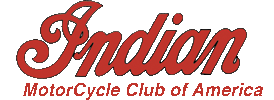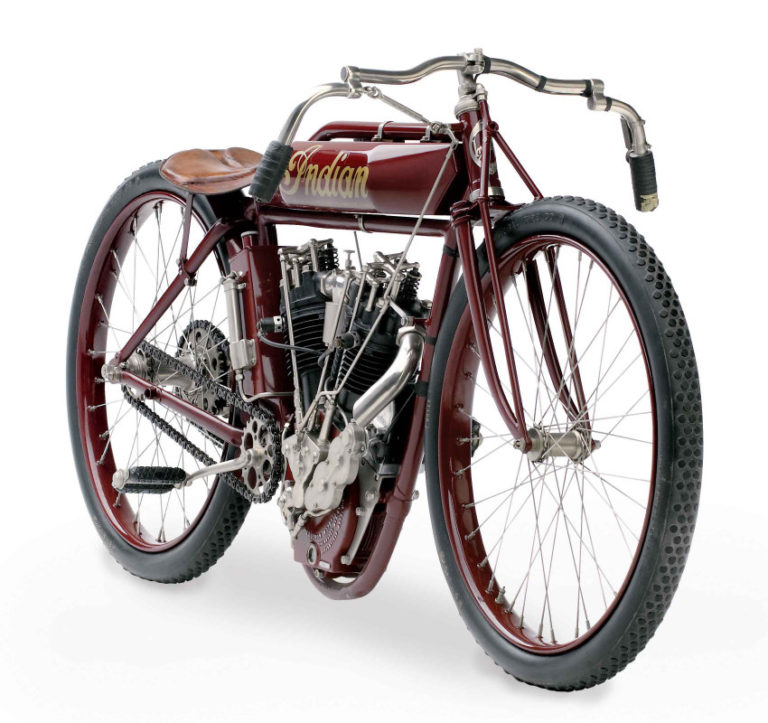Motorcycle board track racing was the deadliest form of racing in the history of motorsports. Hundreds of lives were lost, both racers and spectators, during the relatively short-lived era of the boards. Yet in spite of, or perhaps partly because of, the dangers, motorcycle board track racing in the 1910s was one of the most popular spectator sports in America. Races attracted crowds of up to 10,000 fans. Young riders knew of the dangers, but chose to ignore them because the payoffs were so lucrative. Top racers could make $20,000 per year racing the board tracks, nearly a half-million dollars in today’s currency. From America's Historical Newspapers. The reasons for the lethal nature of motorcycle board track racing were easy to understand. Motorcycles, even in the 1910s, the heyday of the board track era, were capable of speeds approaching 100 miles per hour. The boards were oil soaked and slick due to the engines being of “total loss” design, meaning oil pumped by the riders to lubricate exposed valves and springs sprayed freely into the air behind the speeding bikes. Riders raced with just inches between them, sometimes even touching as riders jockeyed for position. The machines had no brakes, and spectators were separated from the speeding machines by just couple of 2×4 boards nailed between fragile posts.
The first decade of the 20th century, with the advent of automobiles and motorcycles, saw an explosion of race track construction. The mention of motordromes in newspapers began as early as 1901. In the July 18, 1901 edition of the Kansas City Star there was news from Europe of government officials threatening to exclude automobile racing from all public roads and that motordromes could be the solution.
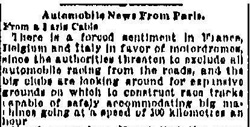
“Automobile News from Paris,” Kansas City Star, (07-18-1901), 7. America’s Historical Newspapers.
Motorcycle racing in America during the early 1900s was primarily confined to city-to-city runs and races on bicycle velodromes. But as engines became more powerful it was clear that the small bicycle tracks were not large enough to showcase the capabilities of motorcycles.
In 1910 the Los Angeles Motordrome, built in the resort of Playa Del Ray, was the first large board track built in America. The Salt Lake Telegram reported on April 9, 1910, that world records were broken in auto races on the new board track. The Albuquerque Journal on the previous day gave some of the specs of the new track. It reported the track “a perfect circle, a mile in circumference, banked one foot in three. The grand stands are placed above the forty-five feet of the inclined track. The surface consists of two by four planks laid to make a four-inch floor and laminated to give great strength. About 3,000,000 feet of lumber and sixteen tons of nails were used in the construction of the ‘pie-pan,’ as it has been dubbed.”

“World’s Records Are Broken On New Board Track,”
Salt Lake Telegram, (04-09-1910), 23.
America’s Historical Newspapers.
Jack Prince, the builder of the Los Angeles track, traveled the country proposing board tracks to city fathers and motor clubs. The Salt Lake Telegram reported on April 26, 1910, that Prince planned to build a half-mile motordrome in Salt Lake City at a cost of $100,000. The paper later reported, on June 18, 1910, that the new board track at Wandamere Park in Salt Lake City was constructed in less than two weeks.
Soon motordromes were being built across the country. And the races drew large crowds. The Salt Lake Telegram on July 4, 1910, reported a crowd of 8,000 to 10,000 on the grand opening night of the Wandamere Motordrome. The race featured Jake De Rosier, the great Indian Motorcycle factory rider, as the main attraction.
The Philadelphia Inquirer on June 15, 1912, reported the grand opening of Philadelphia’s Pointe Breeze Park Motordrome. Pointe Breeze would become one of the most successful board tracks with a regular weekly program. Two of the leading motorcyclists of the era Morty Graves and Eddie Hasha were the featured riders that opening night at Pointe Breeze.
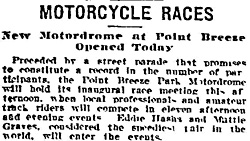
“Motorcycle Races New Motordrome at Point Breeze Opened Today,” The Philadelphia Inquirer, (06-15-1912), 11. America’s Historical Newspapers.
The safety failings of board track racing became all too obvious not long after the facilities were built. The Salt Lake Telegram on July 5, 1912, reported a serious accident in which a rider named Harry Davis was killed and seven spectators injured when Davis’s motorcycle crashed into and snapped a light pole. Throughout that summer a week rarely went by without reports of a rider or spectators being killed at the motordromes.
Two accidents in particular permanently tainted the reputation of the motordromes and eventually led motorcycle racing’s governing body to no longer sanction board track races. The first was a tragic accident at the motordrome in Newark, New Jersey, on September 8. 1912. The Lexington Herald on Sept. 9, 1912, reported that two racers (Eddie Hasha and Johnny Albright) died when they crashed into the outside rail. Four spectators were killed in the incident as well and 19 others suffered injuries. The story of this accident ran in newspapers across the country.
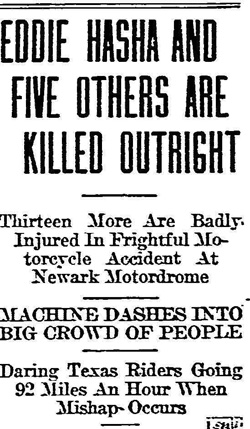
“Eddie Hasha and Five Others Are Killed Outright. Thirteen More Are Badly Injured in Frightful Motorcycle Accident at Newark Motordrome,” Lexington Herald, (09-09-1912), 1. America’s Historical Newspapers.
The following summer, on July 20, 1913, a freak accident at a board track across the river from Cincinnati in Ludlow, Kentucky, caused more outrage. A racer named Odin Johnson crashed; his motorcycle hit a light pole, kicking off a tragic domino effect. The motorcycle’s gas tank exploded. An exposed electrical wire from the light pole then sparked the fuel, spreading flames into the crowd. The ultimate death toll was eight as reported by the Salt Lake Telegram on August 1, 1913. Afterwards the widow of Johnson vowed to devote her life to ending races on board tracks.
The headline of an editorial in the August 1, 1913, edition of The Evening Press (Grand Rapids, Mich.) put it succinctly—“Thrills and Funerals.” The board tracks were referred to as “Murderdromes.”
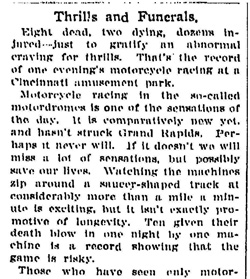
“Thrills and Funerals,” Grand Rapids Press, (August 1, 1913), 6. America’s Historical Newspapers.
A Salt Lake Telegram article on August 22, 1914, tracked the rise and fall of the motordromes, citing the numerous deaths as well as revelations of fixed races as the causes of the decline of motorcycle board track racing.
By the end of the 1910s the board track era was largely a thing of the past. Besides the dangers of racing the boards, the tracks rapidly deteriorated and many burned down. A thrilling but deadly chapter in American motorsports came to a close.


